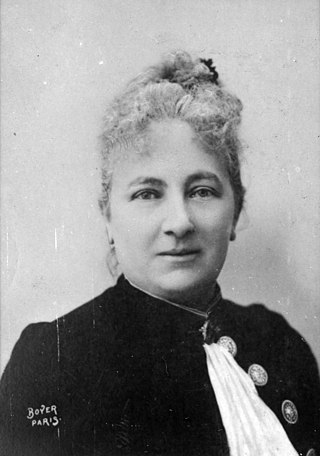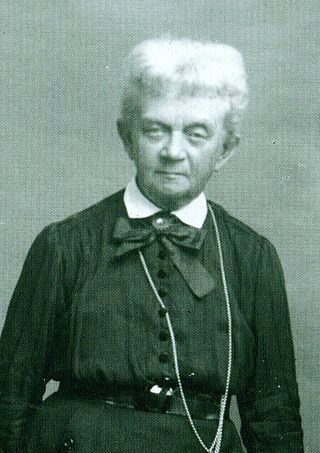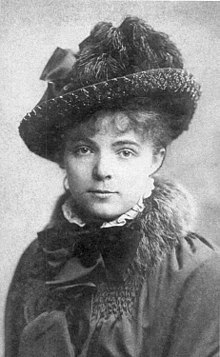
Henri René Albert Guy de Maupassant was a 19th-century French author, celebrated as a master of the short story, as well as a representative of the naturalist school, depicting human lives, destinies and social forces in disillusioned and often pessimistic terms.
Events from the year 1881 in art.

Jules Bastien-Lepage was a French painter closely associated with the beginning of naturalism, an artistic style that grew out of the Realist movement and paved the way for the development of impressionism. Émile Zola described Bastien-Lepage's work as "impressionism corrected, sweetened and adapted to the taste of the crowd."

Paula Modersohn-Becker was a German Expressionist painter of the late 19th and early 20th century. She is noted for the many self-portraits the artist produced, including nude self-portraits. She is considered one of the most important representatives of early expressionism, producing more than 700 paintings and over 1000 drawings during her active painting life. She is recognized both as the first known woman painter to paint nude self-portraits, and the first woman to have a museum devoted exclusively to her art. Additionally, she is considered to be the first woman artist to depict herself both pregnant and nude and pregnant.

Rosalba Carriera was an Italian Rococo painter. In her younger years, she specialized in portrait miniatures. Carriera would later become known for her pastel portraits, helping popularize the medium in eighteenth-century Europe. She is remembered as one of the most successful women artists of any era.

Juliette Adam was a French author and feminist.

Louise Catherine Breslau was a German-born Swiss painter, who learned drawing to pass the time while bedridden with chronic asthma. She studied art at the Académie Julian in Paris, and exhibited at the salon of the Société Nationale des Beaux-Arts, where she became a respected colleague of noted figures such as Edgar Degas and Anatole France.

Amélie Beaury-Saurel was a French painter noted for portraiture.

Marie Bracquemond was a French Impressionist artist. She was one of four notable women in the Impressionist movement, along with Mary Cassatt (1844–1926), Berthe Morisot (1841–1895), and Eva Gonzalès (1847–1883). Bracquemond studied drawing as a child and began showing her work at the Paris Salon when she was still an adolescent. She never underwent formal art training, but she received limited instruction from Jean-Auguste-Dominique Ingres (1780–1867) and advice from Paul Gauguin (1848–1903) which contributed to her stylistic approach.

Prince Bojidar Karageorgevitch was a Serbian artist, art writer, world traveller, and member of the Serbian Karađorđević dynasty. He gave singing and drawing lessons and later earned his living as an art critic and translator. He was a contributor to the Encyclopædia Britannica, Le Figaro, La Revue de Paris, Revue des Revues, Magazine of Art, and other publications.

Susan Isabel Dacre (1844–1933), known as Isabel Dacre, was an English artist of the Victorian era.

Catherine Marthe Louise Pozzi was a French poet and woman of letters.

Mary Diana Lee Sheriff was an American art historian, and W.R. Kenan, Jr. Distinguished Professor of Art History at University of North Carolina at Chapel Hill who specialized in eighteenth-century French art, decorative arts, gender studies, and material culture.
The Affairs of Maupassant is a 1935 Austrian-Italian drama film production. The German title is Das Tagebuch der Geliebten and the Italian title is Il diario di una donna amata, which means "the diary of a woman in love". An historical romance, it was directed by Henry Koster under his original name of Hermann Kosterlitz and starred Isa Miranda as the Ukrainian artist and diarist Marie Bashkirtseff and Hans Jaray as the French writer Guy de Maupassant. It was loosely based on Bashkirtseff's diaries, in which she records her studies in Paris to become an artist towards the end of the 19th century, and possibly on her correspondence with Maupassant, which she had begun under an assumed name. The film focuses on a feud between Maupassant and one of Bashkirtseff's teachers that leads to a nascent romance between Bashkirtseff and Maupassant. The romance is cut short in the film by Bashkirtseff's early death from tuberculosis. The film was made just before Koster moved to the United States to join Universal Studios. It was filmed in Vienna.

Marie Magdeleine Real del Sarte or Real del Sarte (1853–1927) was a French painter and model.

Anna Christina Nordgren was a Swedish painter and draftswoman. She specialized in portraits and genre scenes. Her work is mostly a variation on the Academic style and she remained unimpressed by Impressionism.

Caroline Emilie Mundt was a Danish painter, known for her portraits of children.

Mary Jane Christie Serrano was a writer, poet and considered one of the best known translators in the United States.

Madeleine Zillhardt was a French artist, writer, decorator and painter. Her life and career are linked to another artist, the German-Swiss painter Louise Catherine Breslau, of whom she was the companion, the muse and the inspirer. They lived together for more than forty years, and their lives turned towards the arts. She was the sister of painter Jenny Zillhardt.

Joan of Arc is an oil on canvas painting by Jules Bastien-Lepage, from 1879. It was exhibited at the Exposition Universelle in Paris in 1889. It is held in the Metropolitan Museum of Art, in New York.































